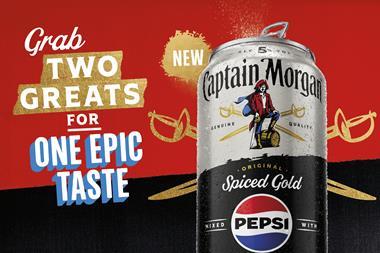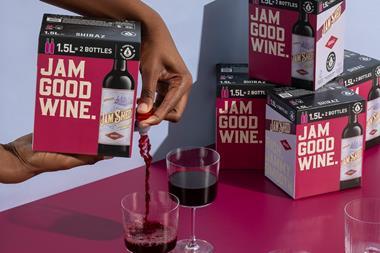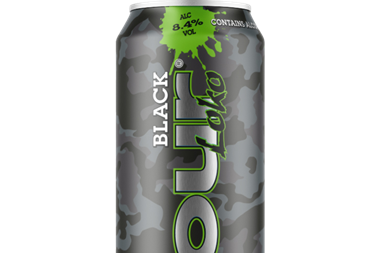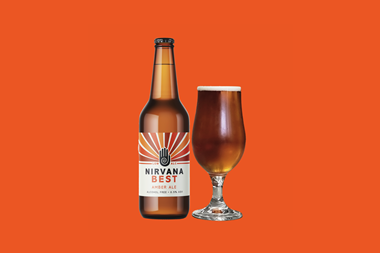Who would have thought it? Cider has become sophisticated. Well, nearly. Once the red-headed stepchild of the alcohol sector, it has now become the prodigal son, returning to drive some much-needed innovation and growth into the category. With value and volume sales growing 5% and 1.3% respectively, is this the golden (liquid) age of cider?
Mintel senior drinks analyst Chris Wesson believes there will be bite in the cider market for some time yet.
“Cider’s time in the limelight shows no signs of ending imminently and it remains a market in strong value growth,” he says. “While volumes remain broadly stagnant, this is a considerably better scenario than the declines afflicting competing markets such as beer. The majority of cider brands are enjoying a halcyon era, with unusually strong expansion over the past five years, and the market has evolved through flavour innovation and the entry of beer brewers such as Stella Cidre.”
He says that flavour has been one of the key drivers of success for cider. “Flavour innovation continues to offer a lucrative opportunity for brands, with Strongbow Dark Fruit the latest in a line of successful recent launches,” says Wesson. “Indeed, sales of flavoured ciders now exceed those of apple or pear among packaged ciders in the on-trade.”
Build basket spend with food matching
Food matching with alcohol doesn’t have to be restricted to wines. Retailers looking to add a little bit of theatre to their cider display could do a lot worse than placing some meal suggestions for customers to enjoy with their drink.
SHS Drinks’ Debs Carter says food matching is an opportunity for retailers to build up that basket spend. “There’s a great deal of interest around food-matching drinks - not just wine, but also beer and cider which also offer a wide spectrum of flavours to complement different dishes,” she says. “Independents could enhance the customers’ shopping experience by, for example, featuring shelf-strip tasting notes, food-matching suggestions which can be found on brands’ websites, and even offering seasonal recipes and tips within the cider fixture.”
Westons Cider’s Ian Lewis says this type of product knowledge could convince shoppers to purchase. “We would recommend that retailers provide their customers with as much product information as possible,” he says. “This allows the shopper to make informed choices and consequently know exactly what they are buying. By providing tasting notes, pos and information on the brands’ background you are allowing shoppers to understand the products.”
Dennis Williams of Premier Broadway, Edinburgh, has seen his alcohol sales skyrocket thanks to cider. “It’s been a real winner for us over the past year with cider sales growing,” he says. “If the summer is as good as it was last year, I think cider is going to do very well for us.”
Adam Moody of Moody’s Londis in Embleton, Northumberland, says it is not just in the summer that the category does well. “It’s ticking over all year round,” he says. “We have quite a small store so we have to be careful about what we stock. We can’t afford to have anything that doesn’t justify its space, but there’s no danger of that with cider.”
Debs Carter, marketing director of alcohol at SHS Drinks, says glass bottled cider has done particularly well in impulse. “In the take home market as a whole, cider is outperforming all other long alcohol drinks (LADs) sectors including lager, ale, stout, RTDs and perry, as well as wines and spirits,” she says. “In the impulse sector, the glass bottled cider sector, in particular, has been very buoyant over the past year with sales growing by 10% in volume and 13% in value - pretty much in line with the total take home market performance - and the category now delivers £74m worth of sales for impulse retailers.
“The fact is that more adults are consuming cider and including it as part of their drinks repertoire. During the course of a year, the number of adults consuming cider increased from 47% to 60%,” says Carter. “Much of the growth is being driven by innovation which has not only increased the consumer base by attracting new consumers into the category, but has also expanded the usage occasions for cider.”
Ian Lewis, head of marketing at Westons Cider, believes the category is attracting new drinkers that are realising there is more to it than meets the eye. “More people are continuing to enter the cider category and, in turn, are working their way from value, mainstream ciders through to premium ciders such as Henry Westons and Old Rosie,” he says. “While people explore the category, and the various style variations within it, the field has seen an increase of interest from more educated consumers who have a genuine understanding and knowledge of the liquid inside the bottle. As a result there has been a real demand for brands that showcase quality and have a real story to tell. Subsequently ‘craft’ cider products have seen a real surge in interest as a direct result of this shift, and more producers are entering the market as quality produce is truly appreciated.”
Londis retailer Adam believes the growth is coming from promotions. “We have Westons Cider on offer at ‘3 for £5’ and Stowford Press at ‘4 for £4’ and customers love these promos,” he explains. “We’ll rotate them to keep the offers fresh but any decent promotion will do well in our store.”
Minesh Patel of Quick Stop Express in Croydon, South London, says younger customers are behind the growth in cider sales in his store. “18-30 year-olds are the ones starting to buy cider more, especially fruit cider,” he says. “They’re the ones who are looking to innovate and try something new.”
Minesh says that fruit ciders are doing extremely well in his store. “Kopparberg, Rekorderlig and Brothers all do great with us,” he says. “The fruit cider market has attracted a lot of interest with customers experimenting with different brands.”
Swedish pioneer leads flavour revolution
When he took over the closed cider brewery in a small town north of Stockhom back in 1994, Peter Bronsman had no idea that he would start the global fruit cider revolution with Kopparberg.
He says that cider was “missing something” back then and the public needed educating about the different types of cider available. “It would be like the wine industry only focusing on red wine and ignoring white,” he says. “We launched a pear cider even though everyone said no-one would make one, but now everyone has one.”
The Swedish alcohol industry is strictly regulated and drinks with an ABV of 3.5% or more are only sold in state-run sites known as Systembolagets, of which there are only 426 large stores and 500 smaller agents for the entire country.
While this may seem a strange environment for any alcohol brand to be successful, Bronsman believes that UK c-stores could learn from their practices. “Their range is exceptional and there’s never a question of availability,” he says. “They also have some great ideas for customers such as food matching suggestions on every drink to give shoppers as much information as possible.”
Bronsman says there is still plenty of growth in cider but that the flavour revolution may have to stop. “The next step is take more market share from spirits and wine but not more flavours,” he says.
Glen Friel, sales and marketing director at Aston Manor Cider, is hopeful for another strong summer for cider. “I think this summer will see continuing growth at both ends of the spectrum, in both premium ciders but also in own label, as warm weather brings new customers to try the category,” he says. “Both of these areas will see people continue to move away from the more mainstream brands.”
He believes that more cider drinkers will shift upwards to premium offerings.
“In the premium segment I expect apple to continue to grow as certain drinkers seek differentiation from the mainstream trade up,” says Friel. “There has been a shift in consumers switching into value and premium apple segments and moving away from some of the mainstream brands. As the category matures, drinkers are looking for more interesting propositions - which is where brands such as Kingstone Press work well.”
Kopparberg customer marketing manager Ben Turner says that cider will benefit from overall taste trends this year. “Elderflower is a big consumer trend right now, and we’re well-placed to exploit it with our elderflower & lime variant,” he says.
Looking ahead, Heineken off trade managing director Martin Porter says that customers are experimenting more, and suppliers need to be ready to innovate like Heineken has with new flavours. “Classic cider is the category’s largest segment and its performance has largely been driven by innovation from Strongbow,” he says. “As a result, shoppers and consumers are extending the search for new cider experiences to more drinking occasions, and Strongbow Citrus Edge has the quality credentials to complement the success of Strongbow dark fruit in 2014.”
Display pays
Friel believes that a mixture of brands and craft is the key to success. “On the drinks fixture, it is important to make sure prominence is given to the most popular brands,” he says. “Cider is also a strong impulse purchase in the right formats such as smaller pack sizes and cans. It therefore makes sense to stock the chiller cabinets with some options for consumers.
“Sales for middle ground mainstream brands are in decline, so retailers should ensure that they offer the right choice to their customers depending on their shopper profile,” he adds. “While fruit cider is important, apple remains king - so I would advise offering balance.”
Minesh says there is quite a lot for retailers to choose from, but he ensures he does his research to make sure he’s getting the right products in.
“It can get confusing at times - you have to have the core range but also something new for customers,” he says. “I’ll look at what people are drinking in nearby bars as that’ll be what people are buying to drink at home as well. It’s a good measure when deciding new lines.”
It’s a tale of two locations for Mandeep Bassi, who runs two stores in Edinburgh. His Best-one store in Saughton Mains Gardens focuses mainly on core, while his M&S Grocers in Greenhills has a customer base that’s willing to innovate. “Alcohol is the main driver of sales in my Greenhills store and cider is a big part of that,” he says. “The fruit cider brands do very well here as they’re bought by people on their way home from work.”
Mandeep sticks to the big brands with a little innovation mixed in. “We keep it simple and stock what we know our customers like,” he says. “If we have some gaps to fill, we’ll put in another Kopparberg line to add some variety to the offering.”
‘Deseasonalisation’ strategy aims to heat up winter sales
While cider may seem like a traditional summer drink, the seasonal barriers are being slowly broken down in the sub-category, with brands offering different variants to attract year-round drinking.
Kopparberg’s raspberry variant, which was a summer-only offering in previous years, is now available all year round as a permanent line, while Rekorderlig’s Winter Cider hopes to attract customers outside of cider’s traditional association with sunshine and summer afternoons.
Linsey Adams, customer marketing manager at Chilli Marketing, says that year-round ciders have grown the market. “Deseasonalisation of cider has played a part in the overall growth of the market, as cider drinking becomes a year-round occasion thanks to a change of perception by the consumer,” he says. “We have met changing consumer tastes with the launch of limited edition variants in both summer and winter to help re-position cider as a drink for all seasons. The deseasonalisation is supported by Rekorderlig’s winter offering, a variant that can be enjoyed both hot and cold, Rekorderlig Winter cider.
“This encourages consumers to drink cider outside of the traditional cider seasons and thus adds value to the market.”
Although the Holy Grail may be to attract 18 to 30-year-olds to your drink, Carter adds that SHS’ Merrydown brand has been focusing its attention on the over-30s with the launch of its medium and blackcurrant ciders last year, and she urges retailers to consider the more mature cider drinker. “There’s a big assumption that the majority of today’s cider drinkers fall within the 18 to 30-year-old age group, so it often comes as a big surprise to retailers when we point out the fact that almost two-thirds (60%) of cider is actually consumed by the over 35s, and that at least two-thirds of consumers aged over 35 drink mostly at home or at a friend’s house.”
Adapt or perish
With so much innovation taking place within the sector, there may be a danger that cider could lose its roots. Friel is concerned that too much variation can impact on value. “An increasing amount of fruit ciders are offering similar taste profiles,” he says. “The concern is fruit cider is continuing to lose sales value per litre. I expect this to continue.”
With a small store, Adam is forced to rotate some of the variants. “There’s so many that I don’t have space to carry them all so I’ll pick a couple, stock them for a few weeks and then introduce new ones,” he says. “It helps keep the display fresh and customers interested. It does force me to make a choice about my range rather than stocking every new launch.”
Minesh says there may be more growth to come in this area. “People are still getting used to flavoured and spirit ciders and are looking to decide which brand to stick with,” he says. “Until that’s decided, we’ll keep trying as many new variants as possible.”
According to Carter, it is pear rather than apple that is feeling the pinch lately. “Flavoured cider has in the last month overtaken apple in volume terms in the impulse sector, taking a 42.9% share versus apple’s 42.5% share, and it has already overtaken apple in value, commanding a 48% share versus apple’s 39% share,” she says. “The sector which is really struggling is pear cider which has seen sales volume and value plummet by -13%, reducing its volume share of glass bottled cider sales from 18% to 15% in the past 12 months.”
Mintel’s Wesson warns that cider is not infallible and that the sub-category needs to tread carefully lest it falls back into old habits. “Problems may lie ahead if flavour innovation loses some of its current cachet or if the image of cider regresses back into more unsophisticated territory in the rush to use new flavours,” he says.
“Indeed, sophistication is one area in which the market continues to under-perform - just 36% of cider drinkers think that it is a sophisticated drink. While many brands are pushing a premium image, they could arguably be doing more and take cues from markets such as wine and whisky.”
IN BRIEF
Lazy Jack’s cider hits the UK
Halewood International has launched Lazy Jack’s, an American-style, cloudy apple cider. Billed as the first of its kind in the UK, the brand is aimed at 22 to 30-year-old consumers. Available in singles (rrp £1.29) and four-packs (rrp £4.89), Lazy Jack’s comes in 355ml bottles with an abv of 4.7%.
Molson offers cherry option
Molson Coors has launched a cherry variant of Carling British Cider. Available through the off trade only, the 4% abv cider comes in 500ml bottles in singles (rrp £2.15) or packs of six (rrp £12).
Rekorderlig unveils new limited edition
Rekorderlig has extended its range to include a limited edition apple and guava variant. Available for the summer, it is hoped the new variant will help further grow the flavoured cider category.
Hornsby’s now available in the UK
C&C Group has introduced US cider brand Hornsby’s to the UK. Available in two variants, crisp apple and pear with strawberry & lime, Hornsby’s comes in four-packs of 330ml bottles. Head of customer marketing Ed Shoebridge says: “Our insight tells us there is a consumer need on more up tempo occasions to have an easy-to-carry drink in one hand.”
Fruit punch
The Stella Artois Cidre range has been extended to include a raspberry variant. Hoping to target more female customers, it is available in 500ml single bottles (rrp £2.19) as well as 4 x 330ml (rrp £5.99) and 8 x 330ml (rrp £11.50) packs with a 4% abv.
Fresh look for Merrydown
Following the successful launch of Merrydown Medium 6% ABV and Merrydown Blackcurrant 4% abv last year, SHS Drinks is now rolling out the new-look pack design across its other cider lines. Both Merrydown Vintage Medium and Dry 750ml glass bottles will be appearing in the new livery from May, and Merrydown Medium 6% abv cider will replace the Merrydown Vintage 7.5% abv ciders in the new look 440ml cans.
Westons helping independents
Westons Cider is to roll out a bespoke support impulse display kit for independent retailers. Created as part of a £3.5m brand investment, the impulse kits include posters, window stickers, shelf barkers and free standing display units. Retailers interested in obtaining a kit can do so by emailing emma.greenow@westons-cider.co.uk.
New Magners competition
Magners has launched an off trade promotion offering consumers the chance to win £1,000 every day between now and June with the brand. Coming under the ‘Now is a Good Time’ marketing campaign, the text-to-win competition is aimed at 20-30 year-olds, a key cider drinking demographic.
Stowford Press glass promotion
Westons Cider has launched an on-pack promotion for Stowford Press. From April until December, consumers have the chance to collect a limited-edition Stowford Press pint glass in a presentation box. The promotion will run on 440ml cans and 500ml bottles.
Old Mout launched in the UK
Heineken has added to its portfolio of flavoured ciders with a new World brand. New Zealand brand Old Mout is available in three flavours - summer berries, passionfruit & apple and kiwi & lime - in 500ml bottles with an abv of 4% and a £2.30-£2.50 price.
Savanna invests in marketing
South African cider brand Savanna has announced a record investment in marketing support for 2014. Savanna’s investment will deliver an integrated campaign of above and below the line marketing initiatives, including national radio advertising, an experiential campaign and an extensive presence at festivals, events and comedy shows.
Amaretto cider launched
SHS Drinks has launched Orwell’s amaretto-flavoured cider. With an abv of 5.5%, the cider comes in 330ml bottles (rrp £1.89). It is hoped the new launch will help grow the £369m (Nielsen) premium glass bottled cider category.




























No comments yet